
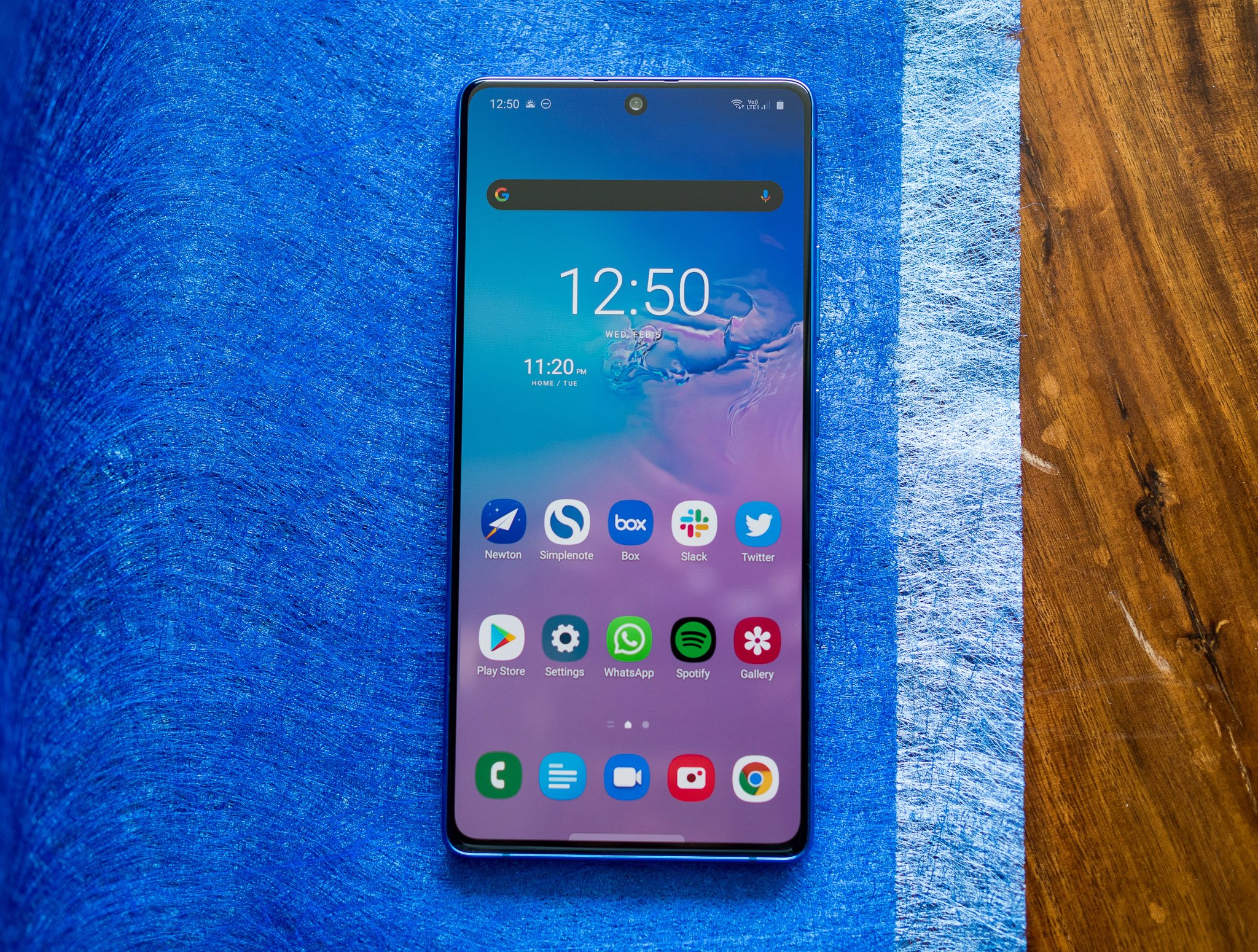 Source: Apoorva Bhardwaj / Android Central
Source: Apoorva Bhardwaj / Android Central

 Source: Apoorva Bhardwaj / Android Central
Source: Apoorva Bhardwaj / Android Central
Samsung is the dominant player in the Android world, and while its flagships continually raise the bar for the industry as a whole, the South Korean brand has failed to make a mark in the mid-range category. Samsung’s efforts in this area over the last four years were focused on the Galaxy A series, a series of mid-range devices aimed at a younger audience that offered several features from the Galaxy S series.
While there were a few noteworthy models in the Galaxy A lineup, they didn’t make a lasting impact in the mid-tier segment. Samsung’s foibles have allowed companies like OnePlus to gain momentum in this category, with the manufacturer opening up a huge lead in key markets like India.
So for 2020, Samsung is switching up its strategy. The manufacturer is getting more aggressive in the mid-range segment, and the Galaxy S10 Lite is the first salvo. The S10 Lite is an interesting device because it brings top-tier hardware and usable cameras at a much more affordable price point when seen against the likes of the Galaxy S10 or Note 10 series.
But the most interesting feature about the S10 Lite is that it comes with Qualcomm’s Snapdragon 855 chipset. That’s a huge deal for Samsung, and it immediately makes the phone that much more exciting. For the first time in over four years, Samsung has made a value flagship that you’d actually be interested in buying.
Don’t be fooled by the naming here — the S10 Lite is one of the fastest phones you’ll use in 2020.
Bottom line: The Galaxy S10 Lite is the best value flagship Samsung has released to date. The Snapdragon 855 chipset has plenty to offer in 2020, and the 4500mAh battery easily delivers over a day’s worth of use. Combine that with decent cameras and Android 10 out of the box, and you get a phone that holds its own against the OnePlus 7T.

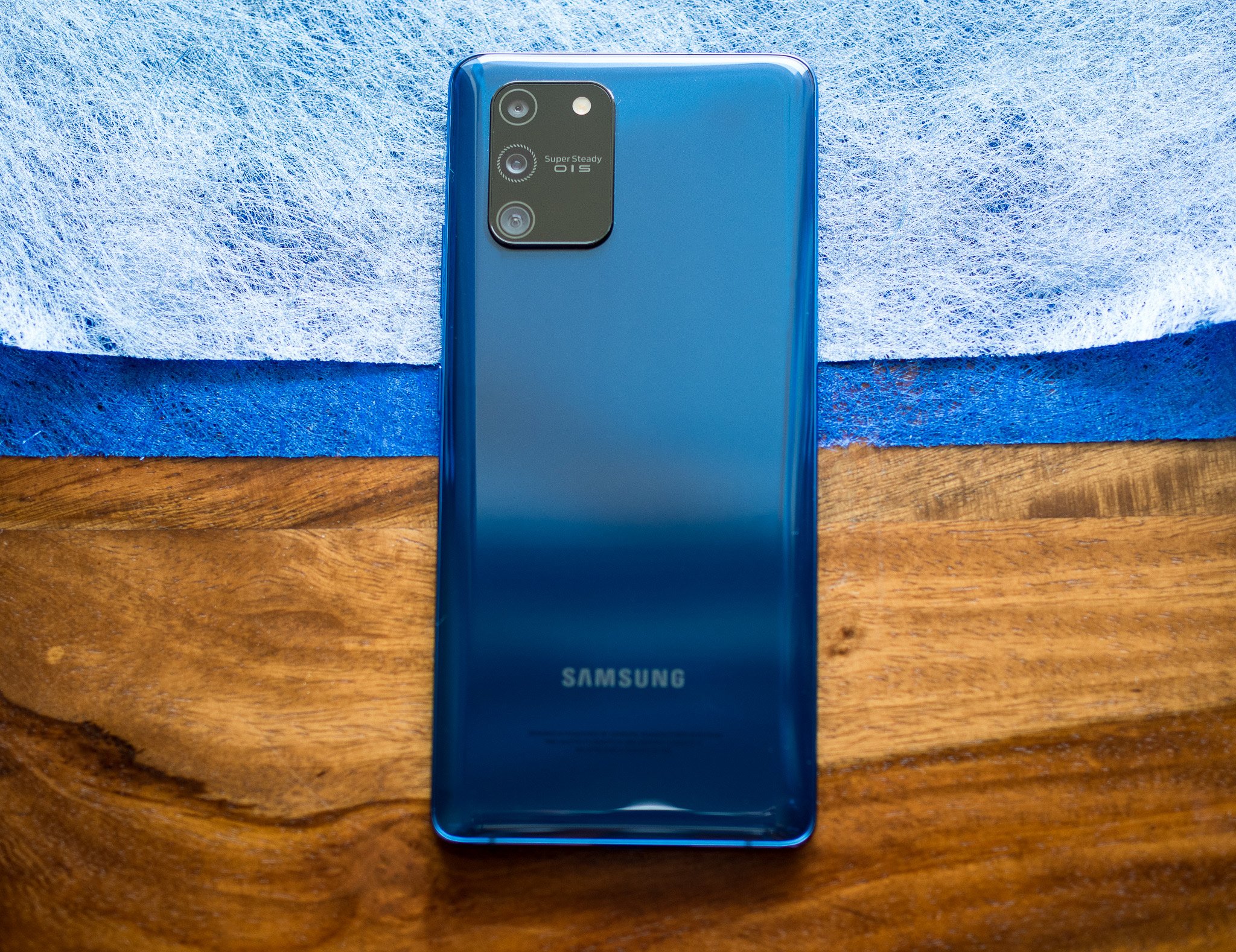 Source: Apoorva Bhardwaj / Android Central
Source: Apoorva Bhardwaj / Android Central
From the back, the Galaxy S10 Lite has more in common with the Galaxy S20 series than the S10. The rectangular camera module makes that immediately evident, and with the Infinity-O cutout at the front — just like the S20 series — the S10 Lite should have been called the S20 Lite instead.
Back to the phone itself: the S10 Lite shares the same industrial design aesthetic as recent Samsung phones, but the main difference is that there’s no glass back. Samsung instead went with a laminated polycarbonate finish that mimics the look and feel of glass.
The S10 Lite has a plastic back, but the laminated finish gives it a glass-like feel.
It’s a smart move because Samsung ends up saving on manufacturing, and you get a phone that’s lightweight and durable while still offering that same glass-like feel at the back. There’s a lot of wasted space around the rear camera housing, and the module itself protrudes slightly from the body, creating a slight wobble when the phone is laid flat on a surface. That said, you should be able to fix it with a case.
Other than that, the S10 Lite feels every bit as premium as any flagship released over the last two years. The back curves gently to meet the metal mid-frame — leading to excellent in-hand feel — and the weight distribution is perfect. The plastic design allowed Samsung to bring down weight to 186g while still offering a 4500mAh battery, and the finish prevented fingerprint smudges from showing up.
Up front, the design is dominated by the Infinity-O cutout, similar to what we’ve seen on the Galaxy Note 10 series. Samsung has tested several camera cutouts over the last 12 months, and it looks like a centered camera is the brand’s go-to choice for 2020. I prefer this to what we got on the S10 last year, as the cutout no longer pushes status icons to the left.
Rounding out the design, you get power and volume buttons on the right, and they’re just as tactile as the ones on the S10 or Note 10. There’s a single speaker tucked away at the bottom next to the USB-C port, and the dual-SIM card tray is located on the right side. The hybrid tray lets you slot in two SIM cards or a nano SIM with a microSD card.
The tall 6.7-inch display isn’t ideal for one-handed use, but the panel itself is fantastic.
There’s no 3.5mm jack on the S10 Lite; Samsung got rid of the analog jack on the Note 10 series, and that trend has continued with the S20 series and S10 Lite. Curiously enough, the Note 10 Lite is the only premium Samsung phone in 2020 to feature the jack.
Interestingly, the S10 Lite offers the largest display of any phone in the S10 series, with the 6.7-inch display easily edging out the 6.4-inch panel on the S10+. It is also 4.9mm taller than the S10+ and is, in fact, taller than the 6.8-inch screen-toting Note 10+. The tall dimensions make it all but impossible to use the S10 Lite one-handed, but the panel quality more than makes up for the sheer size of the phone.
The S10 Lite features a 20:9 Super AMOLED+ panel, and it is one of the best displays you’ll find for under $600. The resolution itself is at 2400 x 1080, but you get excellent color vibrancy and contrast levels. Sunlight visibility is also excellent, and the fact that there’s HDR10+ makes watching videos on Netflix and YouTube that much more enticing.

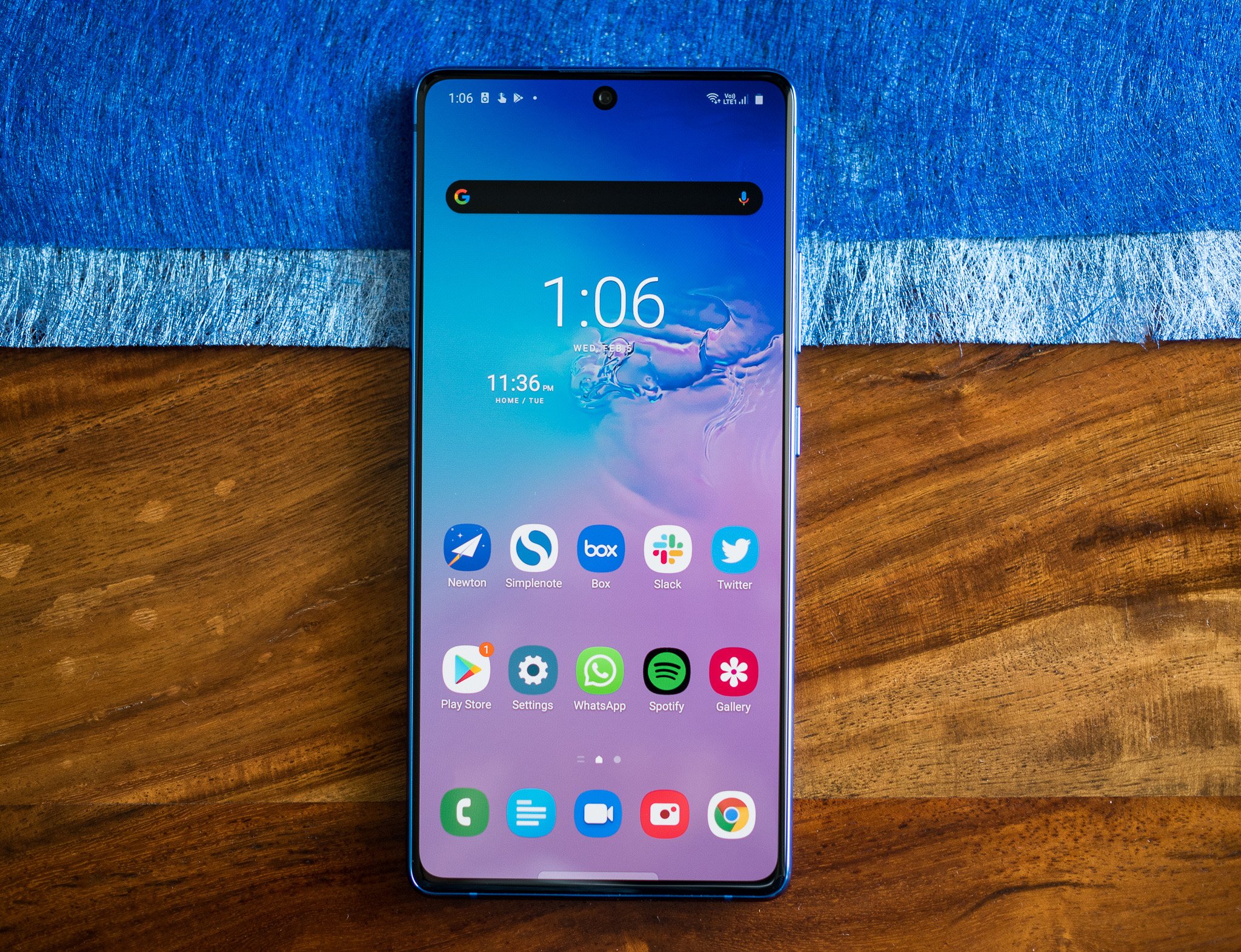 Source: Apoorva Bhardwaj / Android Central
Source: Apoorva Bhardwaj / Android Central
There are several interesting points when it comes to the hardware on the S10 Lite. First up is the fact that it is powered by Qualcomm’s 7nm Snapdragon 855 chipset. That is a big deal because Samsung has always used its in-house Exynos chipsets in its mid-range phones. There have been a few Galaxy A devices over the years that featured Snapdragon chipsets, but for Samsung to offer the flagship Snapdragon 855 in a phone that costs $600 is a fundamental rethinking of its strategy.
| Specs | Samsung Galaxy S10 Lite |
|---|---|
| Software | One UI 2.0 based on Android 10 |
| Display | 6.7-inch (2400×1080) Super AMOLED |
| Chipset | 2.84GHz Snapdragon 855 |
| RAM | 6GB/8GB |
| Storage | 128GB |
| Rear Camera 1 | 48MP ƒ/2.0 (primary) |
| Rear Camera 2 | 12MP ƒ/2.2 (wide-angle) |
| Rear Camera 3 | 5MP ƒ/2.4 (macro) |
| Front Camera 1 | 32MP ƒ/2.2 |
| Connectivity | Wi-Fi 802.11 ac, BT5.0, NFC |
| Battery | 4500mAh | 25W |
| Security | In-screen fingerprint |
| Colors | Prism White, Prism Black, Prism Blue |
| Dimensions | 162.5 x 75.6 x 8.1mm |
| Weight | 186g |
Samsung also outfitted the S10 Lite with a massive 4500mAh battery, but what’s even more interesting is that there’s 25W fast charging. You get a 25W charger in the box, and it gives the phone a definite leg up over the rest of the S10 series. As I mentioned before, Samsung is doing this phone a disservice by branding it under the S10 series.
The massive battery allows the S10 Lite to deliver stellar usage figures, and I routinely got over a day’s worth of use between charges. Even with heavy use that included over seven hours of screen-on-time, the battery never fell under 15% by the end of the day. Samsung’s recent phones have struggled with battery life — particularly in global markets — so it is great to be able to use a phone that delivers excellent figures in this area. When you need to top up, the bundled 25W charger delivers up to a 60% charge in just over 30 minutes.
The Snapdragon 855 chipset immediately turns the S10 Lite into a performance beast. Samsung’s Galaxy A devices have always struggled with performance, but that is not a problem on the S10 Lite. You won’t notice any slowdowns whatsoever, and the Snapdragon 855 has zero issues in day-to-day use.
There’s also 128GB of internal storage as standard, and you can pick up the S10 Lite with either 6 or 8GB of RAM. You also get a Wi-Fi ac modem, Bluetooth 5.0, NFC with Samsung Pay, and an in-screen fingerprint reader that works reliably. You’re missing water resistance and wireless charging here, but that was always going to be the case. Had Samsung included those two features as well, there would be no reason to pick up the standard S10 series over the S10 Lite.
Another interesting point to note is that this is the first time Samsung is offering a high-end Snapdragon chipset in global markets. Barring the U.S. and China, Samsung uses Exynos chipsets exclusively on its phones, so it is a nice change to be able to use Qualcomm hardware on a Samsung phone. In fact, the S10 Lite is the Samsung phone I’ve used that had a high-end Snapdragon chipset, and it was a thoroughly enjoyable experience. The latest Exynos designs aren’t slow by any measure, but they’re not on the same level as Qualcomm when it comes to energy efficiency.

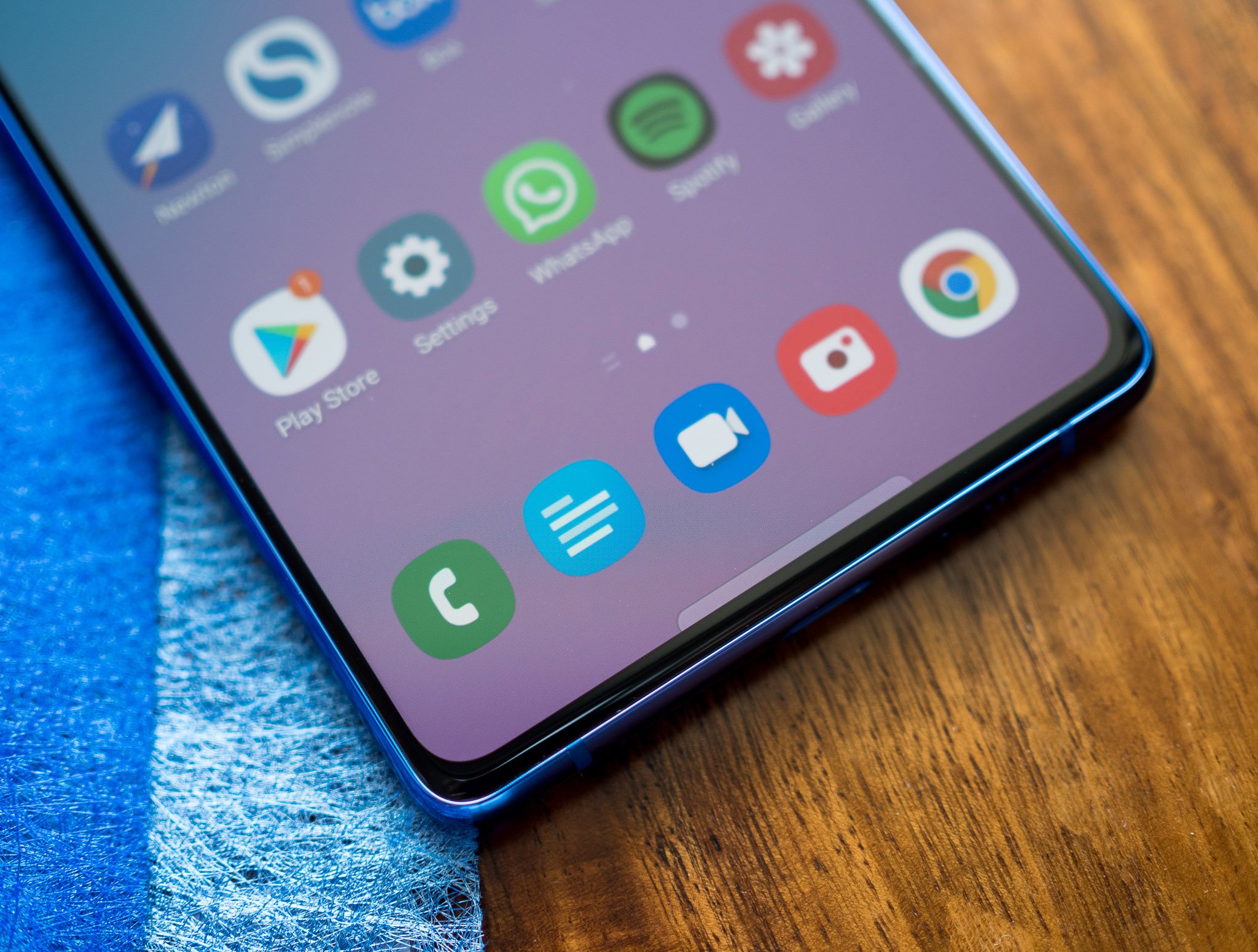 Source: Apoorva Bhardwaj / Android Central
Source: Apoorva Bhardwaj / Android Central
Another area where Samsung has made considerable changes from previous mid-range offerings is the software. The S10 Lite comes with One UI 2.0 based on Android 10 out of the box, and the phone will receive timely updates.
The Snapdragon 855 chipset makes One UI 2.0 absolutely shine in day-to-day use.
While there isn’t a lot of visual redesign from One UI 1.5, Samsung has integrated all the new features in Android 10 into its skin. The most significant change is that the system-wide dark theme works on third-party apps like Chrome and Instagram as well. Features that have been a mainstay on Samsung phones for several generations — like always-on display and Samsung Pay — are back, and you get an exhaustive amount of customizability.
Samsung also offers Android 10’s default gesture navigation as an alternative to the brand’s own gestures, so you have the freedom to pick the navigation style you’re most comfortable with. For a full list of all the new features in One UI 2.0, head to our detailed review.
Samsung has done a decent job cutting down on overt customization in the last two years, and the result is that One UI 2.0 feels modern and polished. There was absolutely no lag anywhere thanks to the Snapdragon 855, and while you’ll still find a few annoyances — like Bixby — Samsung has done a great job cleaning up its interface.

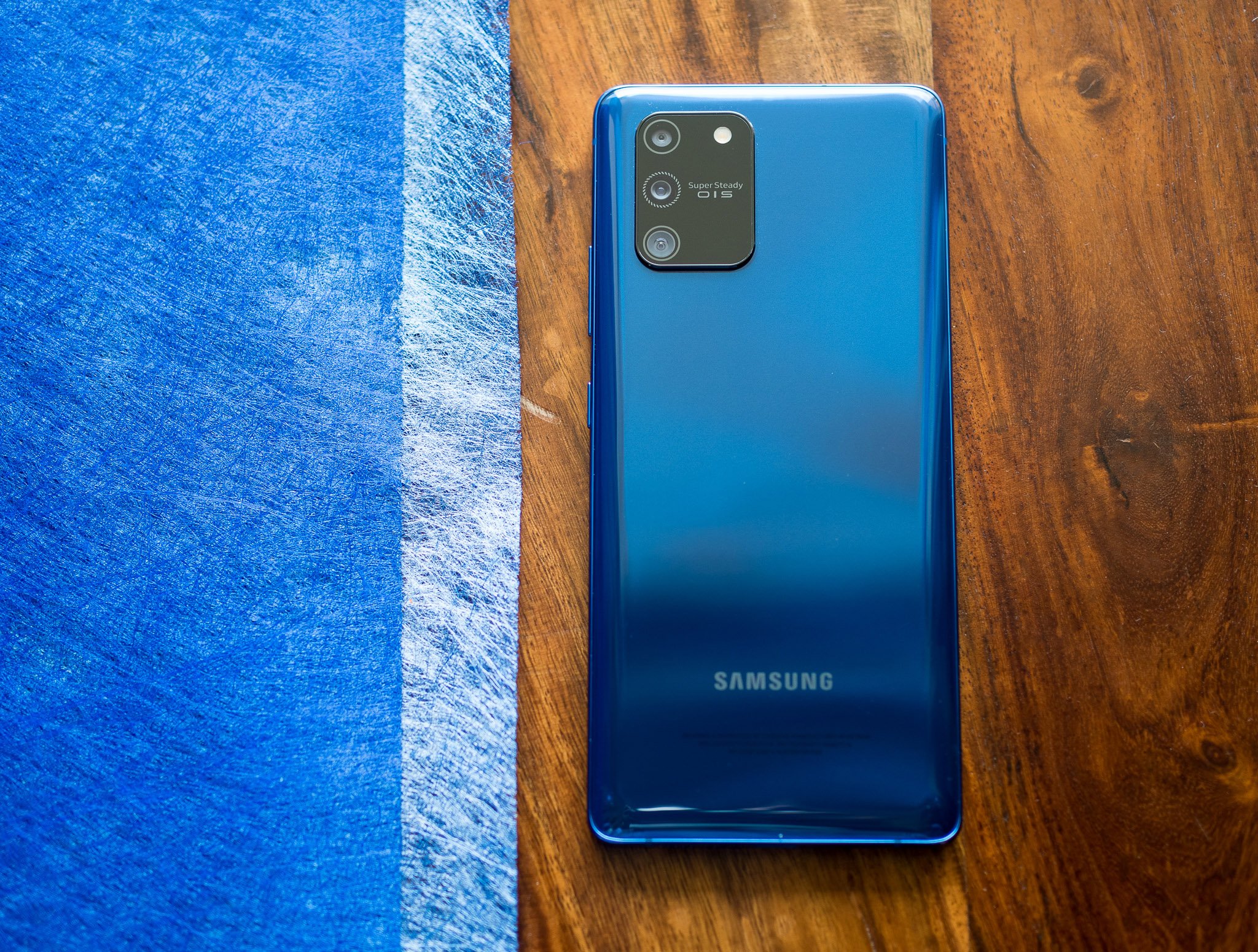 Source: Apoorva Bhardwaj / Android Central
Source: Apoorva Bhardwaj / Android Central
Samsung is touting the camera features on the S10 Lite as a primary differentiator and for a good reason. The phone has a 48MP f/2.0 lens backed by a 12MP wide-angle shooter and a 5MP macro lens, and you get a 32MP camera at the front.
The glaring omission is a zoom lens, with Samsung instead choosing to outfit the S10 Lite with a macro lens instead. This isn’t a new trend, with several Chinese manufacturers going the same route in recent months. To Samsung’s credit, the 5MP shooter is of a higher resolution than what we’ve seen from the likes of Xiaomi and Realme, and in real-world use, the macro lens fared very well.
The camera interface itself has a new design with a cleaner ribbon layout and new toggle icons, but not all shooting modes show up on the bottom bar by default. The macro mode is hidden behind the More menu, so you’ll have to go through a few extra steps to launch the macro lens. You can change this by adding modes you frequently use to the ribbon layout.
You get the option to take motion photos, with the phone recording a few seconds of video just before you press the shutter button. There’s also auto HDR and a host of beautifying effects and filters, and Samsung’s scene optimizer is included here as well. You also get Live focus for both photos and videos, and there’s a toggle that easily lets you switch between the primary and wide-angle lenses.
The S10 Lite takes photos with vibrant and saturated colors, and there’s decent dynamic range here. You get the same caliber of shots from the wide-angle lens as well, and that’s particularly true of images taken in low-light conditions. The primary 48MP lens manages to take great shots in low-light scenarios, with plenty of detail and low noise.

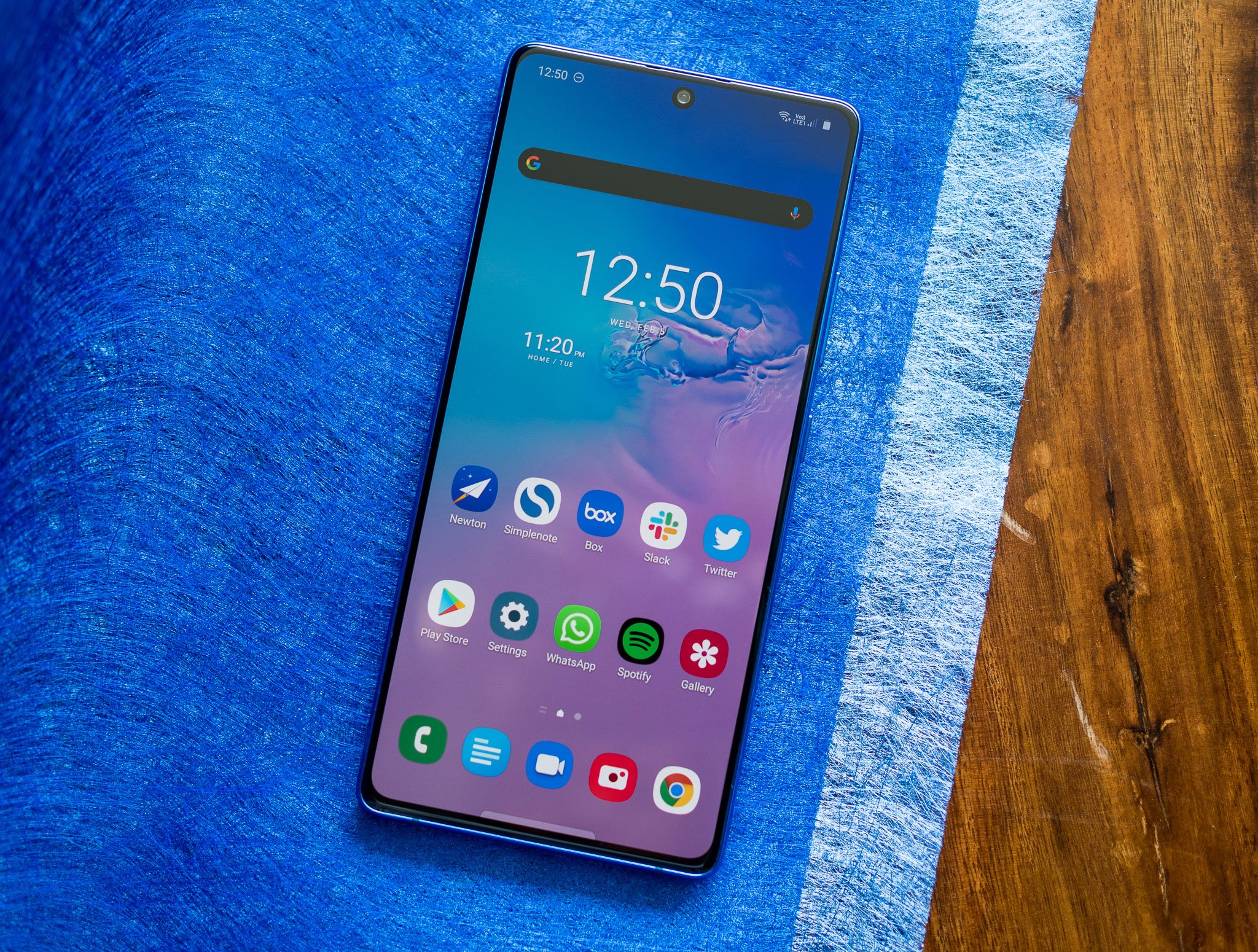 Source: Apoorva Bhardwaj / Android Central
Source: Apoorva Bhardwaj / Android Central
With the S10 Lite, Samsung has finally shown that it can deliver a value flagship that can take on the likes of OnePlus, Xiaomi, and others. The phone absolutely nails the basics, and by going with a Snapdragon 855 chipset instead of an Exynos design, Samsung has ensured that the phone isn’t hobbled in terms of performance.
Then there’s the fact that you’re getting a massive 4500mAh battery with 25W fast charging, making the phone just that much more exciting. The large 6.7-inch AMOLED panel is also one of the best you’ll find in this category, and you get 6GB of RAM with 128GB of storage and a MicroSD card slot. The cameras are also great in their own right, and you get Android 10 out of the box.
The Galaxy S10 Lite is on sale in the U.K. and other global markets, but it is in India where the phone is particularly interesting. Samsung is selling the S10 Lite for ₹39,999 in India, and that comes out to $560. To put things into context, the same phone costs £579 in the U.K., or $755. That’s nearly a $200 difference between the two markets, and it goes to show just how aggressive brands have to be in India to gain market share.
Overall, the S10 Lite is the best value-driven flagship Samsung has launched to date. There really isn’t anything missing here, and when you consider how much the S10 Lite costs, it is a fantastic deal.
The S10 Lite is directly going up against the likes of the OnePlus 7T. OnePlus’ offering has a 90Hz display and cleaner software, and it is available for ₹34,999 ($490) in India. Sure, you’re missing out on the 90Hz refresh rate, but the screen on the S10 Lite is incredible in its own right, and you’re getting much better cameras and significantly better battery life here.
Samsung’s best value flagship to date.
The Galaxy S10 Lite is the best value flagship Samsung has released to date. The Snapdragon 855 chipset has plenty to offer in 2020, and the 4500mAh battery easily delivers over a day’s worth of use. Combine that with decent cameras and Android 10 out of the box, and you get a phone that holds its own against the OnePlus 7T.
We may earn a commission for purchases using our links. Learn more.

LONDON (AP) — Most people have accumulated a pile of data — selfies, emails, videos and more — on their social media and digital accounts over their lifetimes. What happens to it when we die?
It’s wise to draft a will spelling out who inherits your physical assets after you’re gone, but don’t forget to take care of your digital estate too. Friends and family might treasure files and posts you’ve left behind, but they could get lost in digital purgatory after you pass away unless you take some simple steps.
Here’s how you can prepare your digital life for your survivors:
Apple
The iPhone maker lets you nominate a “ legacy contact ” who can access your Apple account’s data after you die. The company says it’s a secure way to give trusted people access to photos, files and messages. To set it up you’ll need an Apple device with a fairly recent operating system — iPhones and iPads need iOS or iPadOS 15.2 and MacBooks needs macOS Monterey 12.1.
For iPhones, go to settings, tap Sign-in & Security and then Legacy Contact. You can name one or more people, and they don’t need an Apple ID or device.
You’ll have to share an access key with your contact. It can be a digital version sent electronically, or you can print a copy or save it as a screenshot or PDF.
Take note that there are some types of files you won’t be able to pass on — including digital rights-protected music, movies and passwords stored in Apple’s password manager. Legacy contacts can only access a deceased user’s account for three years before Apple deletes the account.
Google takes a different approach with its Inactive Account Manager, which allows you to share your data with someone if it notices that you’ve stopped using your account.
When setting it up, you need to decide how long Google should wait — from three to 18 months — before considering your account inactive. Once that time is up, Google can notify up to 10 people.
You can write a message informing them you’ve stopped using the account, and, optionally, include a link to download your data. You can choose what types of data they can access — including emails, photos, calendar entries and YouTube videos.
There’s also an option to automatically delete your account after three months of inactivity, so your contacts will have to download any data before that deadline.
Facebook and Instagram
Some social media platforms can preserve accounts for people who have died so that friends and family can honor their memories.
When users of Facebook or Instagram die, parent company Meta says it can memorialize the account if it gets a “valid request” from a friend or family member. Requests can be submitted through an online form.
The social media company strongly recommends Facebook users add a legacy contact to look after their memorial accounts. Legacy contacts can do things like respond to new friend requests and update pinned posts, but they can’t read private messages or remove or alter previous posts. You can only choose one person, who also has to have a Facebook account.
You can also ask Facebook or Instagram to delete a deceased user’s account if you’re a close family member or an executor. You’ll need to send in documents like a death certificate.
TikTok
The video-sharing platform says that if a user has died, people can submit a request to memorialize the account through the settings menu. Go to the Report a Problem section, then Account and profile, then Manage account, where you can report a deceased user.
Once an account has been memorialized, it will be labeled “Remembering.” No one will be able to log into the account, which prevents anyone from editing the profile or using the account to post new content or send messages.
X
It’s not possible to nominate a legacy contact on Elon Musk’s social media site. But family members or an authorized person can submit a request to deactivate a deceased user’s account.
Passwords
Besides the major online services, you’ll probably have dozens if not hundreds of other digital accounts that your survivors might need to access. You could just write all your login credentials down in a notebook and put it somewhere safe. But making a physical copy presents its own vulnerabilities. What if you lose track of it? What if someone finds it?
Instead, consider a password manager that has an emergency access feature. Password managers are digital vaults that you can use to store all your credentials. Some, like Keeper,Bitwarden and NordPass, allow users to nominate one or more trusted contacts who can access their keys in case of an emergency such as a death.
But there are a few catches: Those contacts also need to use the same password manager and you might have to pay for the service.
___
Is there a tech challenge you need help figuring out? Write to us at onetechtip@ap.org with your questions.

LONDON (AP) — Britain’s competition watchdog said Thursday it’s opening a formal investigation into Google’s partnership with artificial intelligence startup Anthropic.
The Competition and Markets Authority said it has “sufficient information” to launch an initial probe after it sought input earlier this year on whether the deal would stifle competition.
The CMA has until Dec. 19 to decide whether to approve the deal or escalate its investigation.
“Google is committed to building the most open and innovative AI ecosystem in the world,” the company said. “Anthropic is free to use multiple cloud providers and does, and we don’t demand exclusive tech rights.”
San Francisco-based Anthropic was founded in 2021 by siblings Dario and Daniela Amodei, who previously worked at ChatGPT maker OpenAI. The company has focused on increasing the safety and reliability of AI models. Google reportedly agreed last year to make a multibillion-dollar investment in Anthropic, which has a popular chatbot named Claude.
Anthropic said it’s cooperating with the regulator and will provide “the complete picture about Google’s investment and our commercial collaboration.”
“We are an independent company and none of our strategic partnerships or investor relationships diminish the independence of our corporate governance or our freedom to partner with others,” it said in a statement.
The U.K. regulator has been scrutinizing a raft of AI deals as investment money floods into the industry to capitalize on the artificial intelligence boom. Last month it cleared Anthropic’s $4 billion deal with Amazon and it has also signed off on Microsoft’s deals with two other AI startups, Inflection and Mistral.
The Canadian Press. All rights reserved.

DUBAI, United Arab Emirates (AP) — The tiny Mideast nation of Kuwait has banned the release of the video game “Call of Duty: Black Ops 6,” which features the late Iraqi dictator Saddam Hussein and is set in part in the 1990s Gulf War.
Kuwait has not publicly acknowledged banning the game, which is a tentpole product for the Microsoft-owned developer Activision and is set to be released on Friday worldwide. However, it comes as Kuwait still wrestles with the aftermath of the invasion and as video game makers more broadly deal with addressing historical and cultural issues in their work.
The video game, a first-person shooter, follows CIA operators fighting at times in the United States and also in the Middle East. Game-play trailers for the game show burning oilfields, a painful reminder for Kuwaitis who saw Iraqis set fire to the fields, causing vast ecological and economic damage. Iraqi troops damaged or set fire to over 700 wells.
There also are images of Saddam and Iraq’s old three-star flag in the footage released by developers ahead of the game’s launch. The game’s multiplayer section, a popular feature of the series, includes what appears to be a desert shootout in Kuwait called Scud after the Soviet missiles Saddam fired in the war. Another is called Babylon, after the ancient city in Iraq.
Activision acknowledged in a statement that the game “has not been approved for release in Kuwait,” but did not elaborate.
“All pre-orders in Kuwait will be cancelled and refunded to the original point of purchase,” the company said. “We remain hopeful that local authorities will reconsider, and allow players in Kuwait to enjoy this all-new experience in the Black Ops series.”
Kuwait’s Media Ministry did not respond to requests for comment from The Associated Press over the decision.
“Call of Duty,” which first began in 2003 as a first-person shooter set in World War II, has expanded into an empire worth billions of dollars now owned by Microsoft. But it also has been controversial as its gameplay entered the realm of geopolitics. China and Russia both banned chapters in the franchise. In 2009, an entry in the gaming franchise allowed players to take part in a militant attack at a Russian airport, killing civilians.
But there have been other games recently that won praise for their handling of the Mideast. Ubisoft’s “Assassin’s Creed: Mirage” published last year won praise for its portrayal of Baghdad during the Islamic Golden Age in the 9th century.
The Canadian Press. All rights reserved.


Alberta aims to add two seats to legislature, bringing total to 89 for next election


Trump snaps at reporter when asked about abortion: ‘Stop talking about it’


UN refugee chief: Canada cutbacks can avoid anti-immigrant backlash


Pembina Pipeline earnings rise year over year to $385 million in third quarter


Party leaders pay tribute following death of retired senator Murray Sinclair


Canadians remember Quincy Jones


‘He violated me’: Women tell sex assault trial Regina chiropractor pulled breasts


Beyoncé channels Pamela Anderson in ‘Baywatch’ for Halloween video asking viewers to vote